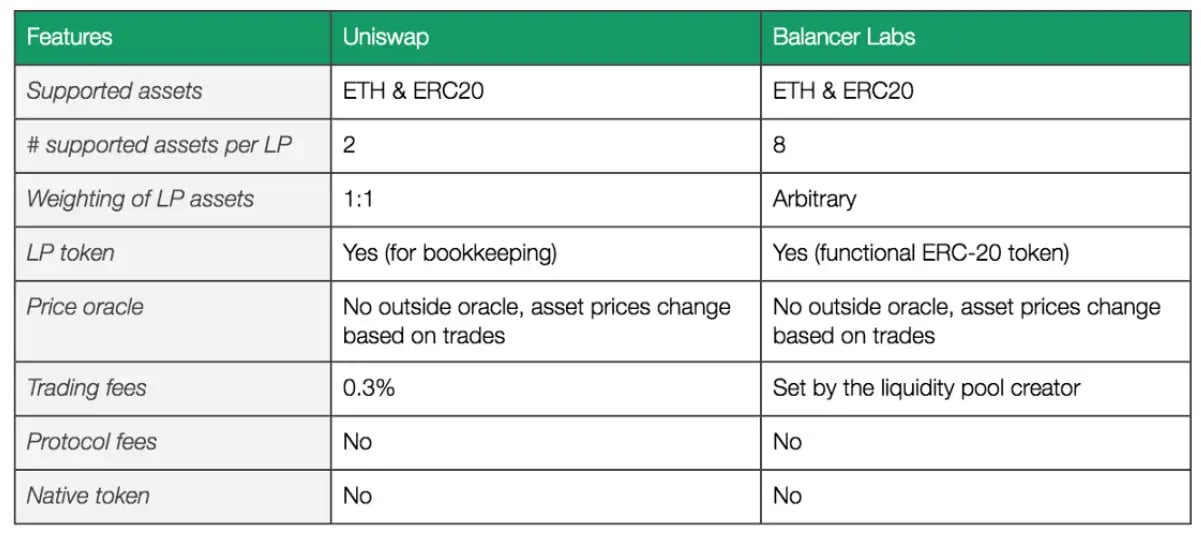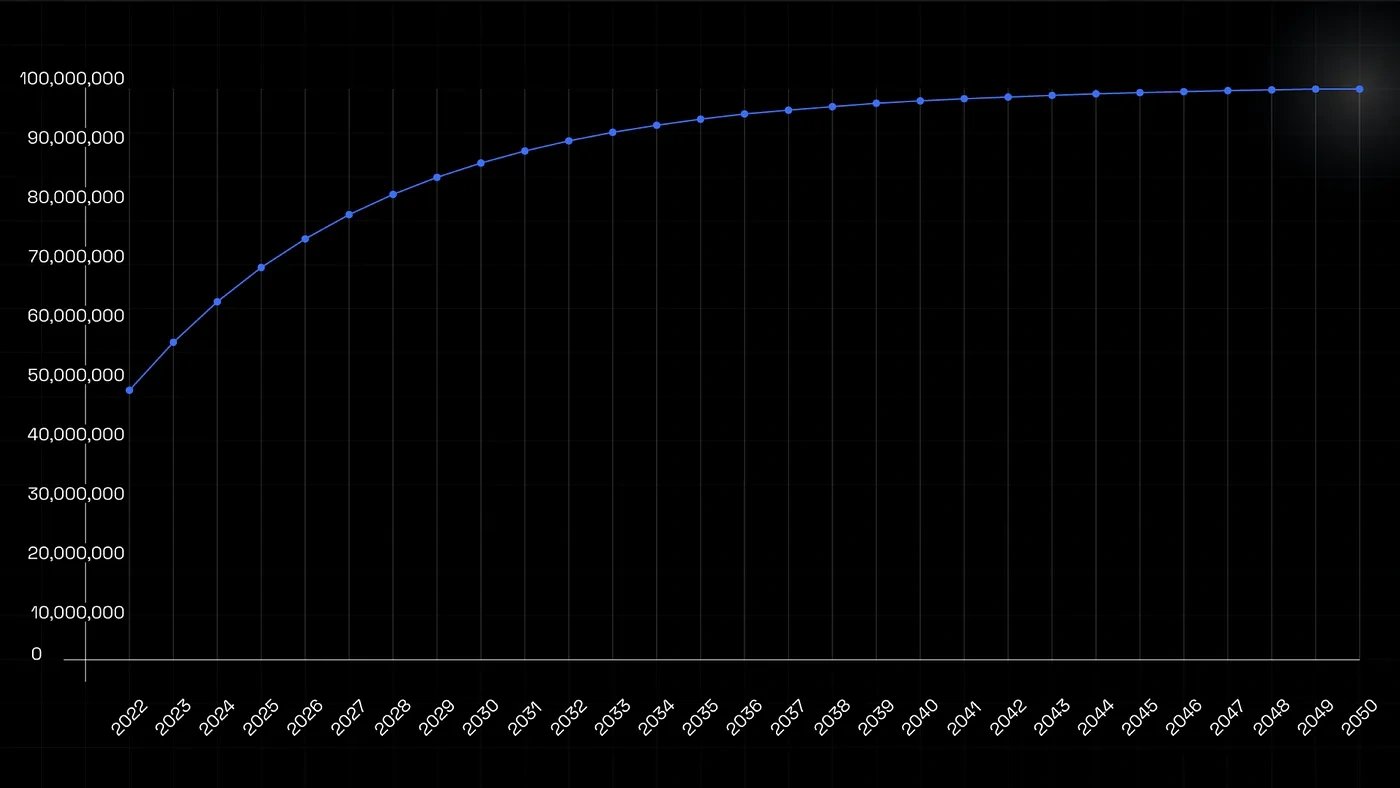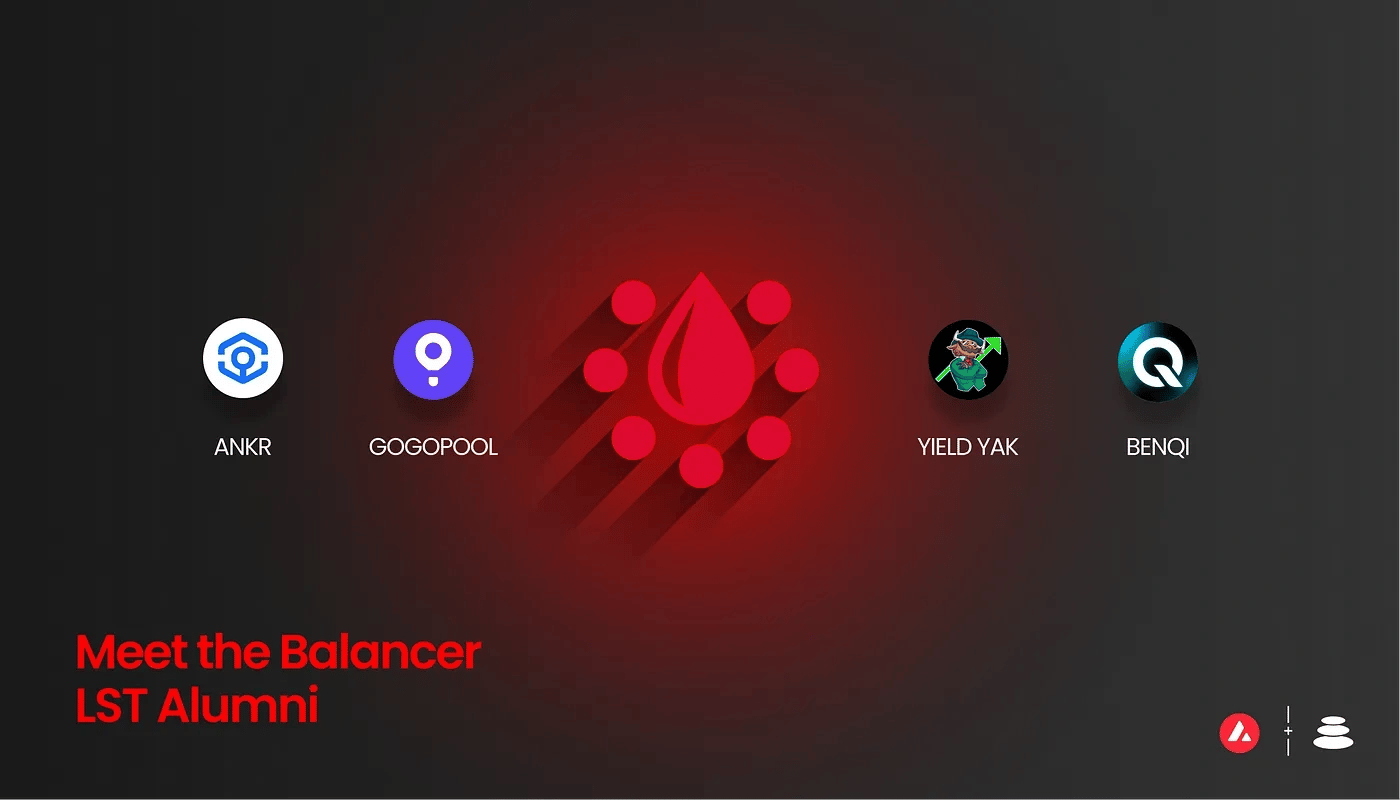위키 구독하기
Share wiki
Bookmark
Balancer
Balancer
Balancer Protocol(2018년 설립)은 오픈소스 프로토콜이자 자동화된 포트폴리오 관리자이며 유동성 제공자입니다. 이 프로토콜을 통해 사용자는 토큰을 거래하고, 유동성 풀을 생성하고, 기존 풀에 투자하여 거래 수익을 얻을 수 있습니다. [1][2][15]
개요
Balancer는 2018년 Fernando Martinelli(페르난도 마르티넬리)와 Mike McDonald에 의해 설립된 다중 토큰 프로토콜입니다. 이름은 플랫폼의 자체 재조정 liquidity pools(유동성 풀)에서 유래되었습니다. 이를 통해 포트폴리오 소유자는 Balancer Pool을 생성하고, 거래자는 이를 이용하여 거래할 수 있습니다. Balancer Pool은 총 풀 가치의 비율을 나타내는 독립적인 가중치를 가진 두 개 이상의 토큰을 포함합니다. 풀은 Balancer Protocol에 유동성을 제공하고, 거래자에게 접근 수수료를 부과합니다. 어떤 사람이든 어떤 풀에서든 두 개의 토큰을 교환할 수 있으므로, 풀은 자동화된 시장 조성자로 간주될 수 있습니다. Balancer V2는 Ethereum(이더리움), Polygon(폴리곤), Arbitrum(아비트럼) 및 특정 테스트넷에서 사용 가능합니다. [15][31]
2021년 8월, Balancer Protocol은 가스 비용을 절감하고 유동성을 확장하기 위해 2계층 확장 솔루션 Arbitrum(아비트럼)에 대한 지원을 시작했습니다. 이 확장을 통해 사용자는 Arbitrum을 사용하여 Balancer 앱에서 거래할 수 있습니다. [32]
2022년 6월, Balancer는 Beethoven X와의 협력을 통해 2계층 롤업 네트워크 Optimism(옵티미즘)에서 출시되었습니다. Balancer에게 제공되는 이점으로는 추가적인 확장성, 스마트 지갑 EOAs(승인 없음, 모든 토큰으로 가스 지불), 및 트랜잭션 시퀀싱 작업의 분산화가 있습니다. [33]
“이번 출시를 통해 Balancer는 Optimism을 선도적인 L2 솔루션으로 인정합니다. 이더리움의 보안을 계승하면서 독특한 확장성은 사용자 경험을 향상시키고 DeFi 성장을 촉진할 것입니다. L2는 거래 수수료와 네트워크 혼잡을 줄일 수 있는 가능성을 보여주며, 저희는 저희 기술을 Optimism 생태계에 제공하게 되어 기쁩니다.” —Fernando Martinelli(페르난도 마르티넬리), Balancer Labs CEO & 공동 설립자. [33]
AMM 프로토콜
Balancer는 자동화된 시장 조성자 (AMM, (오토메이티드 마켓 메이커))로서 기능합니다. Balancer는 대부분의 다른 AMM 풀(예: Uniswap)에서 표준으로 사용되는 두 가지 자산이 아닌 여러 자산을 포함할 수 있는 고유한 유동성 풀을 제공합니다. 이 풀은 스마트 계약을 통해 프로그래밍할 수도 있어 사용자 지정 규칙 및 전략을 구현할 수 있습니다.[8][9]

2020년 10월, Balancer는 NEAR 프로토콜과 파트너십을 맺었습니다. Balancer 팀은 주로 자체 프로토콜의 이더리움 구현에 집중할 것이라고 밝혔지만, Balancer의 성장 책임자인 Jeremy Musighi는 NEAR와의 협력을 통해 Balancer가 더욱 확장 가능한 체인에서 어떻게 작동하는지에 대한 아이디어를 얻을 수 있을 것이라고 말했습니다. [14]
또한, Balancer와 NEAR는 NEAR용 Balancer 프런트엔드 개발과 NEAR 지갑에 Balancer 통합을 장려하기 위해 최대 1만 달러 상당의 두 가지 보조금을 제공하고 있습니다. 이 인센티브는 NEAR 버전의 Balancer 채택과 사용 편의성을 높여 접근성과 사용자 경험을 개선하기 위한 것입니다. 보상은 NEAR 및 BAL 토큰으로 지급됩니다. [14]
밸런서 프로토콜 거버넌스 토큰 (BAL)
밸런서의 첫 번째 버전은 자체 토큰 없이 출시되었습니다. 2020년 6월 1일, BAL 토큰은 밸런서 프로토콜에 유동성을 제공한 사용자들에게 배포되었습니다. 밸런서 프로토콜 거버넌스 토큰(BAL)은 보유자가 새로운 기능, 잠재적인 프로토콜 수수료 또는 밸런서 프로토콜 주변에서 발생하는 다른 개발에 대해 투표할 수 있도록 합니다[6].
토큰 경제학
초기 1억 개의 BAL 토큰 중 2,500만 개의 BAL 토큰은 창립자, 스톡옵션, 자문위원 및 투자자에게 할당되었으며, 모두 상장 제한 기간이 적용됩니다. 500만 개가 더 Balancer 생태계 기금에 할당되었습니다. 이 기금은 Balancer 생태계 성장에 도움이 되는 전략적 파트너를 유치하고 인센티브를 제공하는 데 사용됩니다. 또 다른 500만 개는 모금 기금에 할당되었습니다. [16]
나머지 토큰은 유동성 마이닝이라는 프로세스를 통해 배포됩니다. 매주 14만 5천 개의 BAL이 Balancer 풀에 유동성을 제공하는 사용자에게 지급되며, 연간 총 750만 개의 BAL이 지급됩니다. [16]
2020년 6월 23일, Balancer 프로토콜 거버넌스 토큰(BAL)이 메인넷에서 출시되었습니다. 거래 첫날, 토큰 가치는 한때 7달러에서 22달러로 상승하여 12시간 만에 235%의 급등을 기록했습니다. [6]
veBAL
veBAL (vote-escrow BAL)은 Curve의 veCRV 메커니즘을 기반으로 하는 베스팅 시스템으로, 최대 1년 동안 80/20 BAL/WETH Balancer Pool 토큰을 락업합니다. veBAL은 2022년 3월에 출시되었습니다. [21]
veBAL 토큰은 BAL 보유자와 유동성 제공자에게 다음과 같은 혜택을 제공합니다.
- 장기적 연계 - BPT를 락업함으로써 토큰 보유자는 단기적인 투기 대신 장기적으로 Balancer를 지원하도록 장려됩니다.
- 프로토콜 수익 배분: 프로토콜에서 생성된 모든 수수료의 75%는 veBAL 보유자에게 비례적으로 배분됩니다.
- Curve 생태계와의 Plug&play 호환성
- 예측 가능성[21]
BAL 인플레이션 일정 업데이트
2022년 초 veBAL 토큰 경제로의 이전과 함께 도입된 BAL의 인플레이션 일정에 따르면, 4년마다 BAL의 인플레이션이 절반으로 줄어듭니다. 토큰 경제 모델 출시 1년 후부터 매년 BAL 인플레이션을 줄이기 위한 단계적인 조치가 시행됩니다. 자세한 일정은 다음 그림에서 확인할 수 있습니다.

유동성 풀 및 재조정
사용자는 유동성 풀(유동성 풀)을 생성하거나 기여할 수 있습니다. 유동성 풀은 가중치가 부여된 자산과 생성자가 설정한 거래 수수료로 구성됩니다. 이를 통해 누구든지 자체 균형 조정 인덱스 펀드를 소유하거나 다른 사람의 펀드에 투자하여 다른 사용자가 자신의 포트폴리오와 거래할 때 수수료를 벌 수 있습니다. 스마트 주문 라우팅(SOR)은 최상의 가격으로 풀에 거래합니다. [8]
유동성 풀 생성자는 포트폴리오에 있는 각 자산의 % 가중치를 정의합니다. 풀의 자산이 거래될 때(ETH 대 BAT) BAT의 % 가중치가 감소합니다. 그러나 가격이 상승하여 BAT가 포트폴리오에서 % 가중치를 유지합니다.
포트폴리오의 자산 가격이 시장 가격에서 너무 벗어나면 중재자가 가격 차이를 제거합니다. 외부 가격 오라클이 없으므로 Balancer의 유동성 풀의 자산 가격은 거래가 이루어지지 않는 한 정체되어 있습니다.
Balancer 풀은 몇 개의 토큰으로만 제한되지 않으며 사용자 지정 % 가중치 분포를 사용하여 최대 8개의 토큰을 지원합니다. 예를 들어, 풀은 30% BAT, 30% DAI, 30% USDC, 10% LINK일 수도 있고, 다른 풀은 80% WETH와 20% ZRX일 수도 있습니다.
풀 유형
투자 라운드
2020년 3월, 발란서 랩스(Balancer Labs)는 Accomplice와 Placeholder가 주도하고 CoinFund와 Inflection이 참여한 시드 라운드를 통해 300만 달러의 투자를 유치했습니다.[11]
2020년 11월 9일, 발란서 랩스는 Pantera Capital과 Alameda Research가 회사 자금에서 BAL 토큰을 직접 구매하는 방식으로 투자했다고 발표했습니다. 두 기관 모두 BAL 토큰 보유자로서 자본을 제공할 뿐만 아니라 프로토콜의 최종 사용자로서 추가적인 가치를 제공합니다. [7]
2021년 2월, 발란서 랩스는 알려지지 않은 투자자들로부터 시리즈 A 투자금 500만 달러를 유치했습니다. 2021년 5월에는 Blockchain Capital, Continue Capital, Fenbushi Capital, FinTech Collective, Kain Warwick, 그리고 LongHash Ventures를 통해 벤처 라운드에서 2430만 달러를 유치했습니다. [18]
발란서 풀 해킹
2020년 6월 28일, 해커가 AMM과 디플레이션 토큰 모델의 취약점을 악용하여 최소 두 개의 발란서 멀티토큰 풀이 50만 달러 이상의 손실을 입었습니다[13].
공격자는 단일 트랜잭션에서 여러 작업을 자동화하는 스마트 계약(https://iq.wiki/wiki/smart-contract)을 배포했습니다. dYdX에서 104,000 WETH의 플래시론을 이용하여 시작했습니다. 이 플래시론은 WETH를 STATERA (STA) 토큰으로 24번 왕복 교환하는 데 사용되었고, 이로 인해 풀의 STA 잔액이 1 weiSTA(0.000000000000000001 STA)가 되었습니다[13].
이 공격이 성공한 이유는 토큰 잔액이 발란서 풀에서 추적되고 STA 토큰이 수신자에게 1%의 이체 수수료가 부과되는 디플레이션 모델을 가지고 있었기 때문입니다. 이로 인해 transfer() 및 transferFrom()에서 오류가 발생했습니다. 공격자가 WETH를 STA로 교환할 때마다 발란서 풀은 예상보다 1% 적은 STA를 받았습니다. 그런 다음 공격자는 1 weiSTA를 WETH로 여러 번 교환했습니다. STA 토큰 이체 수수료 구현으로 인해 풀이 STA를 받지 못했음에도 불구하고 WETH가 출금되었습니다. 공격자는 Wrapped Bitcoin(WBTC), SNX, Link 토큰 잔액도 같은 방식으로 풀에서 빼냈습니다[13].
공격을 완료하기 위해 해커는 dYdX에 104,000 WETH의 플래시론을 상환하고 몇 weiSTA를 예치하여 발란서 풀에서 자신의 지분을 빠르게 늘렸습니다. 마지막으로 공격자는 Uniswap V2를 통해 발란서 풀 토큰을 136,000 STA로 교환한 다음 136,000 STA를 다시 109 WETH로 교환했습니다. 공격자는 스마트 계약에 대한 광범위한 지식을 가지고 있었고, 초기 자금을 얻고 Ethereum의 출처를 숨기기 위해 토네이도 캐시를 사용했습니다[13].
Balancer V2
2021년 2월, Balancer팀은 프로토콜 업그레이드인 Balancer V2를 공개했습니다. Balancer V2의 핵심 원칙은 보안, 유연성, 자본 효율성 및 가스 효율성입니다. 주요 특징으로는 모든 Balancer 풀 자산을 위한 Protocol Vault, 향상된 가스 효율성, 권한 없는 사용자 지정 AMM 로직, 자산 관리자를 통한 자본 효율성, 낮은 가스 비용 및 안정적인 오라클, 그리고 커뮤니티가 관리하는 프로토콜 수수료가 있습니다[7][8].
프로토콜 볼트
Balancer V1과 Balancer V2의 주요 아키텍처 변경 사항은 모든 Balancer 풀에 추가된 모든 자산을 보유하고 관리하는 단일 볼트로의 전환입니다. Balancer V2는 자동 시장 조성자 (AMM) 로직을 토큰 관리 및 회계와 분리합니다. 토큰 관리/회계는 볼트에서 수행되는 반면, AMM 로직은 각 풀에 개별적으로 적용됩니다. 풀은 볼트 외부의 계약이므로 임의의 사용자 지정 AMM 로직을 구현할 수 있습니다. [8]
가스 효율성
Balancer V1에서는 두 개 이상의 풀을 이용한 거래가 가스 효율이 낮습니다. 사용자가 모든 풀에서 ERC20 토큰을 주고받아야 하기 때문입니다. Balancer의 새로운 Protocol Vault를 사용하면 여러 풀에 대해 일괄적으로 거래가 이루어지지만, 최종 순이익 토큰 금액만 금고에서 주고받으므로 상당한 가스 비용을 절감할 수 있습니다. 최종 순이익 금액만 전송되므로 차익거래도 훨씬 쉬워집니다. 토큰이 없지만 Balancer 풀 간의 가격 비대칭을 감지한 차익거래자는 풀 1에서 DAI를 MKR로, 풀 2에서 MKR을 BAL로, 풀 3에서 BAL을 DAI로 거래하여 DAI로 이익을 얻을 수 있습니다[15].
Balancer V2를 사용하면 사용자는 내부 토큰 잔액을 보유할 수 있습니다. 예를 들어, 사용자가 토큰 A를 토큰 B로 거래하지만 몇 시간 후에 B를 A로 다시 거래할 것을 알고 있다면 첫 번째 거래 후 B를 인출할 필요가 없을 것입니다. Balancer는 다음 거래에 사용할 수 있는 금고에 두 토큰을 모두 보관하여 ERC20 거래를 완전히 피할 수 있습니다[8].
사용자 지정 AMM 로직
Balancer V2는 저수준 토큰 전송, 잔액 회계, 보안 검사 및 스마트 주문 라우팅에 대해 고려하지 않고도 다양한 AMM 전략으로 혁신할 수 있는 출시 기반을 마련하여 사용자 지정 가능한 AMM 로직을 개척합니다. 출시 시 Balancer V2는 가중치 풀(Balancer v1과 같은 일정 가중치, 인덱스 펀드 스타일 풀)과 서로 소프트 페깅된 토큰에 적합한 안정적인 풀(Curve Finance 팀의 작업을 기반으로 함)을 제공합니다. 출시 직후 파트너가 구축한 지속적인 매개변수 변경 및 기타 여러 유형의 풀을 허용하는 스마트 풀을 제공할 예정입니다. 모든 풀은 스마트 주문 라우터로 인해 거래 유동성을 제공합니다. [8]
Balancer V2 자산 매니저
Balancer V2에서 자산 매니저는 풀에 예치된 기저 토큰에 대한 완전한 권한을 가진 외부 스마트 계약(스마트 컨트랙트)입니다. 자산 매니저는 풀의 수익률을 높이기 위해 대출 프로토콜에 토큰을 대출할 수 있습니다. 볼트에는 항상 버퍼가 유지되어야 합니다. 그렇지 않으면 거래가 실패할 수 있습니다. 볼트는 풀을 대신하여 현재 보유하고 있지 않은 자산을 거래할 수 없기 때문입니다.[9][10]
2021년 2월 23일, Balancer는 Aave ($AAVE)와 파트너십을 맺고 첫 번째 Balancer V2 자산 매니저를 구축하여 V2 풀의 유휴 자산으로 Aave에서 수익을 얻을 수 있게 했습니다. 이 파트너십을 통해 Balancer의 자본 효율성이 향상되어 유동성 제공자는 스왑 수수료와 유동성 마이닝으로 얻는 BAL 외에 추가 수익을 얻을 수 있습니다.
자동 시장 조성자의 자연스러운 결과로, 가격이 한 방향으로 변하기 시작하면 더 비싸지는 토큰이 풀에서 더 부족해집니다(즉, 사용자가 구매하면서 잔액이 감소합니다). 즉, 해당 토큰의 현금 금액이 0이 될 때까지 고갈됩니다. 그 시점에서 해당 토큰을 구매하려는 스왑 시도는 실패합니다. 이때 Aave-Balancer 자산 매니저가 Aave에서 투자된 토큰의 일부를 상환하고 Balancer 볼트로 다시 보내 스왑 실패를 방지함으로써 해당 토큰의 현금 금액을 보충합니다. 자산 매니저는 또한 풀에서 더 풍부해지는 토큰의 투자 금액을 늘리기 위해 더 많은 토큰을 Aave로 보내 수익을 극대화합니다. [10]
낮은 가스 비용과 안정적인 오라클
Balancer V2는 누산기를 사용하여 샌드위치 공격에 강한 오라클을 포함합니다. 또한, dApp은 최소한의 가스 비용으로 과거 누산기 상태를 저장하지 않고도 가격을 조회할 수 있습니다. Balancer 팀은 낮은 가스 비용으로 조회할 수 있는 두 가지 유형의 가격을 제공할 계획입니다. 즉각적인 가격(최신 가격이지만 조작에 취약함)과 안정적인 가격(최신 가격이 아니지만 조작에 강함)입니다. 가격 유형의 선택은 각 사용 사례에 따라 달라집니다. 예를 들어, 대출 프로토콜은 안정적인 가격에 의존할 가능성이 높지만, 예측 시장은 즉각적인 가격을 사용할 수 있습니다. [9]
관리 가능한 프로토콜 수수료
Balancer가 커뮤니티 중심 프로토콜로 전환됨에 따라, Balancer V2는 거버넌스(BAL 토큰 보유자)가 제어하는 세 가지 유형의 프로토콜 수준 수수료를 구현합니다.
- 거래 수수료: 트레이더가 풀 LP에 지불하는 거래 수수료의 작은 비율입니다.
- 인출 수수료: Balancer Protocol Vault에서 인출되는 모든 토큰의 작은 비율입니다(거래 제외). Balancer 풀 간에 유동성을 이동하는 것은 이 수수료가 발생하지 않습니다.
- 플래시 론 수수료: Balancer 볼트에서 플래시 론으로 사용되는 자산의 작은 비율입니다.
거래 수수료와 인출 수수료는 처음에는 꺼져 있고, 플래시 론 수수료는 Balancer에서 플래시 론을 생성하는 데 항상 자본 비용이 있도록 작은 값으로 시작합니다. 처음에는 모든 프로토콜 수수료가 볼트에 보관됩니다. 이러한 수수료의 사용 여부 및 방법은 Balancer 거버넌스가 결정합니다.
유동성 마이닝
Balancer V2 발표 직후, Balancer 공동 설립자 겸 최고운영책임자(COO) Mike Ray McDonald(마이크 레이 맥도널드)가 Balancer 거버넌스 포럼에 게시글을 올려 사용자들에게 V2 유동성 마이닝 매개변수에 대한 "브레인스토밍"을 제안했습니다. 새로운 유동성 마이닝 프로그램의 목표는 "핫 토큰"과 이 토큰들이 가져올 거래 수수료에 대한 풀을 신속하게 제공할 수 있을 만큼 민첩성을 유지하는 동시에 V1의 "롱테일" 자산에 대한 초점과는 달리 지속 가능성과 단순성을 보장하는 데 있습니다. McDonald는 또한 유동성 마이닝 프로그램과 이 프로그램이 제공하는 커뮤니티 인센티브에 대한 개선이 완전히 분산된 거버넌스에 대한 장기적인 비전의 일부라고 썼습니다.
“목표는 사용자와 시간에 걸쳐 가능한 가장 넓은 분포를 달성하여 프로토콜의 분산된 소유권 및 거버넌스를 확보하는 것입니다.”
안정적인 풀
2021년 7월, 발란서(Balancer)는 발란서 V2에서 안정적인 풀(Stable Pools)을 출시했습니다. 안정적인 풀은 유사한 가격으로 거래되는 자산을 위해 특별히 설계되었으며, 이는 동종 자산 스왑의 자본 효율성을 크게 높입니다. 트레이더는 더 좁은 스프레드와 더 낮은 슬리피지를 누리고, 유동성 제공자는 매우 적은 임시 손실로 경쟁력 있는 수익률을 얻습니다. [22]
메타스테이블 풀 출시 | 리도(Lido)(리도) 파트너십
2021년 8월, 발란서(Balancer)는 리도(리도)와의 파트너십과 함께 메타스테이블 풀(MetaStable Pools) 출시를 발표했습니다. 메타스테이블 풀은 수수료가 점진적으로 누적되는 페깅 토큰을 처리하는 데 적합합니다. [23]
메타스테이블 풀의 사용 사례는 다른 풀을 “중첩”하여 발란서 풀 토큰(BPT)을 보유함으로써 구성 토큰과 중첩된 풀의 토큰 간의 저렴한 스왑을 가능하게 하는 것입니다. 마치 모든 구성 토큰이 단일 풀에 있는 것처럼 말입니다. 스테이블 풀은 1:1 환율의 토큰에 적합하지만 메타스테이블 풀은 가치가 점진적으로 달라지는 토큰에 적합합니다. [23]
리도(Lido)(리도)는 메타스테이블 풀 출시와 함께 이더(이더)와 스테이킹된 이더(스테이킹된 이더) 간의 거래를 용이하게 하는 풀을 출시하여 이더리움(이더리움) 네트워크를 보호하는 스테이커에게 유동성을 제공했습니다. 이더리움 스테이킹 커뮤니티를 위해 유동성 풀의 수를 늘리고 리도의 stETH(리도의 stETH) 토큰에 대한 증가하는 유동성 조건을 지원했습니다. [23]
파트너십
발란서 x 그노시스
2021년 4월, 발란서(Balancer)는 그노시스(Gnosis)와 파트너십을 맺고 새로운 탈중앙화 거래소(DEX)를 개발했습니다. 새로운 발란서-그노시스-프로토콜(BGP)은 발란서 v2에 내재된 개선된 볼트 시스템과 그노시스가 고안한 가격 발견 메커니즘을 결합하는 것을 목표로 합니다. BGP는 UX, 가격 책정 및 투명성에 대한 새로운 기준을 설정할 것입니다. 채굴자 추출 가치(MEV)를 사용하며, 경매 시스템을 통해 더 나은 가격을 얻습니다. 이 DEX는 2021년 6월 중순에 출시될 예정이지만, PoC인 CowSwap( "Coincidence of Wants"의 약자)은 이미 운영 중입니다. CowSwap의 주요 USP는 가스 없는 거래를 지원하는 기능으로, 거래는 오프체인으로 처리되며 네트워크 수수료가 없습니다. [19]
Balancer x Certora
2022년 10월, Balancer(밸런서)는 보안 감사업체 Certora(세르토라)와 파트너십을 맺고 Balancer Certora Security Accelerator(밸런서 세르토라 보안 액셀러레이터)를 출시하여 Balancer 기반 프로젝트의 코드 보안 강화를 지원했습니다. Security Accelerator(보안 액셀러레이터)는 코드 검토를 제공하고 Certora의 공식 검증 Prover(프루버)에 대한 접근 권한을 부여합니다. 이러한 제휴는 코드베이스의 안전성을 강화하고 향후 프로젝트의 시장 출시 과정을 간소화할 것입니다. [20]
“Balancer와 Certora Security Accelerator의 출시는 스마트 계약 도구를 통해 Balancer의 성장하는 개발자 생태계의 보안을 강화하는 것을 목표로 합니다. Security Accelerator는 프로젝트에 보안 검토 및 소프트웨어 도구에 대한 추가적인 접근 권한을 제공하여 Balancer 기반 개발을 더욱 실행 가능한 옵션으로 만듭니다.” — Fernando Martinelli, Balancer Labs CEO & 공동 설립자 [20]
Balancer x Polygon zkEVM
2023년 6월, Polygon Labs(폴리곤 랩스)는 Ethereum(이더리움)의 확장성 및 최종성을 기하급수적으로 향상시키기 위한 첫 번째 단계로 zkEVM 메인넷 베타 버전을 출시했습니다. EVM과 동등한 2계층 ZK 확장 솔루션입니다. Balancer는 네트워크에 자체 기술을 배포하여 유동성 성장을 지원하고 생태계 전반의 개발을 가속화하고 있습니다. [40]
zkEVM은 제로 지식 증명 계산을 EVM과 동등한 2계층에 결합하여 사용자와 개발자에게 원활한 암호화 방식의 확장 솔루션을 제공합니다. Polygon Labs는 이 기술이 alt-L1, 낙관적 롤업 및 기타 ZK-롤업보다 더 나은 성능, 더 높은 처리량, 더 낮은 대기 시간 및 더 낮은 비용으로 동일한 코드와 앱을 제공할 수 있다고 믿습니다. [40]
발란서 x 애벌랜치(Avalanche)
2023년 8월 1일, 발란서(Balancer)는 애벌랜치(Avalanche)에서 출시되어 유동적 스테이킹 토큰 시장을 강화하고 사용자에게 DeFi를 위한 유연한 기술 스택을 제공했습니다. 발란서는 LST 성장을 촉진하기 위해 맞춤형 기술 스택을 제공하고자 해당 체인에 기술을 배포할 것입니다. [42]
발란서와 4개의 LST 프로토콜은 유동적 스테이킹 토큰 시장을 통합하기 위해 협력합니다. 발란서는 BenQi의 sAVAX, Ankr의 ankrAVAX, Yield Yak의 yyAVAX, GoGoPool의 ggAVAX에 대한 유동성을 제공하여 애벌랜치 LST 시장을 활성화할 것입니다. [43][45]

Balancer x Base
2023년 8월 3일, Balancer는 Coinbase에서 지원하는 Ethereum 레이어-2 플랫폼 솔루션인 Base와의 파트너십을 발표했습니다. Base에서 Balancer를 출시하는 것은 여러 주요 분야(Boosted Pools, LST, ve8020, 대출 시장 등)에서 Base 생태계의 DeFi 확장을 가속화하는 것을 목표로 합니다. [44][45][46]
밸런서 에코시스템 런치패드 (Balancer Ecosystem LaunchPad)
8020 이니셔티브
2023년 7월 6일에 도입된 8020은 80%의 한 자산과 20%의 다른 자산으로 구성된 두 가지 자산 풀을 의미합니다. 8020 이니셔티브는 단일 토큰 대신 8020 풀 BPT 토큰을 거버넌스 토큰으로 사용하는 것을 제안하며, 프로토콜의 네이티브 토큰 80%와 해당 체인의 기본 토큰 또는 유동성이 높은 스테이블코인 20%로 구성된 풀 구성을 사용합니다. [34][35]
이 모델은 높은 유동성, 비대칭적 상승, 감소된 무상실(IL), 효율적인 인센티브 프로그램, 헤징/가격 상승 등의 다양한 이점을 제공합니다. [35]

LST 유동성 허브
2023년 5월 3일, 발란서(Balancer)는 자사 기술이 이더리움(Ethereum)에서 $rETH 유동성을 20배 증가시키는 데 기여했다고 트윗했습니다.
"생태계 전반의 빠른 유동성 성장을 촉진하며, 발란서가 왜 DeFi의 유동성 스테이킹 토큰(LST) 허브가 될 준비가 되었는지 알아보세요" [36]
발란서의 합성 안정 풀은 수익률 생성 토큰의 모든 힘이 유동성 제공자에게 흘러가도록 프로그래밍 방식으로 조정됩니다. 합성 안정 풀은 내장된 비율 제공자를 활용하여 블록체인을 지속적으로 쿼리하고, 토큰을 정확한 비율로 업데이트하며, 수익률 발생을 유동성 풀로 다시 공급합니다. 비율 제공자 기술이 없으면 두 자산은 1:1로 거래되며 스테이킹 수익률의 증가분은 차익거래자에게 유출됩니다. [37]
합성 안정 풀의 통합은 효율적인 유동성 스테이킹 토큰(LST) 인센티브 선순환도 가능하게 합니다. 이러한 토큰의 이점이 실제로 사용자에게 돌아가면 발란서는 이렇게 손실되었을 이점에 대해 수수료를 부과할 수 있습니다. 전략적으로 구현된 핵심 풀 메커니즘에 통합된 이 수수료는 투표 인센티브로 풀에 다시 공급되어 효율적이고 지속적인 유동성 성장의 선순환을 촉진합니다. [37]
부스트 풀 (Boosted Pools)
2023년 4월 26일에 도입된 부스트 풀(Boosted Pools)은 유동성 풀과 단일 사이드 수익 시장의 장점을 결합하여 역동적인 포지션을 만듭니다. 일반적인 유동성 풀은 스왑을 용이하게 하는 유동성이 20% 미만인 반면, 부스트 풀은 유휴 유동성을 외부 수익 창출 프로토콜로 리다이렉트합니다. 이를 통해 사용자에게 지속 가능한 추가적인 유동성 마이닝 인센티브가 제공됩니다. [37][38]
이러한 고유한 풀 유형의 예로는 이더리움의 Balancer Boosted Aave V3 USD가 있습니다. 이 트라이 스테이블 부스트 USDC/USDT/DAI 풀은 프로토콜에 여러 USD 토큰에 대한 효율적인 스왑 경로에 대한 즉각적인 접근을 제공하며, 페어링 초기 단계에서 사용자의 효율성을 추가적으로 높여줍니다. [38]
기반 계층을 구축하여
Balancer는 기반 계층을 통해 다른 프로토콜과 개발자가 작업을 단순화하여 시간과 자원을 절약함으로써 코딩 시간을 줄이고 구축 시간을 늘리는 것을 장려합니다. [37] 예를 들어, Gyroscope 프로토콜은 최적화된 Balancer 기술 스택을 사용하여 고유한 E-CLP 집중 유동성 모델을 구축했으며, 이는 풀이 처음 2주 동안 4,100,262달러의 집중 스왑을 가능하게 했습니다. [39]
취약성 공격
2023년 8월 22일, 발란서 랩스(Balancer Labs)는 발란서 TVL의 약 4%를 차지하는 여러 풀에 영향을 미치는 심각한 취약성 보고를 받았습니다. 발란서 팀은 사용자들에게 "영향받는 LP를 즉시 인출하라"고 권고했습니다. 사용자는 발란서 개인화 UI를 통해 연결된 지갑이 영향받는 풀과 관련되어 있는지 확인할 수 있습니다. [48]
이에 따라 긴급 서브DAO([47])는 영향받는 모든 풀에서 비례적 인출을 가능하게 하고 일시 중지 기간 내에 있는 풀을 일시 중지했습니다. [48]
2023년 8월 23일 몇 시간 후, 팀은 트위터(현재 X)에서 취약성의 97% 이상이 해결되었고 총 TVL의 0.89%가 여전히 위험에 처해 있지만 아무것도 악용되지 않았으며 사용자는 자금을 최대한 빨리 인출하라는 권고를 발표했습니다.
"발란서 LP의 신속한 조치 덕분에 초기 취약하다고 여겨졌던 유동성의 97% 이상이 안전합니다. 취약성은 악용되지 않았지만, 총 TVL의 0.89%(560만 달러)가 여전히 위험에 처해 있으며, 사용자는 UI를 사용하여 최대한 빨리 인출하라는 권고를 받았습니다."[49]
잘못된 내용이 있나요?
